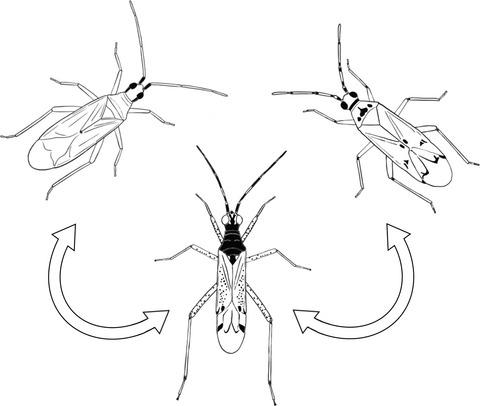当前位置:
X-MOL 学术
›
Entomol. Exp. Appl.
›
论文详情
Our official English website, www.x-mol.net, welcomes your
feedback! (Note: you will need to create a separate account there.)
Intraguild predation and cannibalism among Dicyphini: Dicyphus cerastii vs. two commercialized species
Entomologia Experimentalis et Applicata ( IF 1.4 ) Pub Date : 2020-06-18 , DOI: 10.1111/eea.12943 Gonçalo Abraços Duarte 1, 2 , Filipa Caldas 1 , Ariadna Pechirra 1 , Elsa Borges da Silva 1, 3 , Elisabete Figueiredo 1, 2
Entomologia Experimentalis et Applicata ( IF 1.4 ) Pub Date : 2020-06-18 , DOI: 10.1111/eea.12943 Gonçalo Abraços Duarte 1, 2 , Filipa Caldas 1 , Ariadna Pechirra 1 , Elsa Borges da Silva 1, 3 , Elisabete Figueiredo 1, 2
Affiliation

|
Dicyphine mirids are one of the most important groups of predators on tomato. In the Mediterranean region, several species in the genera Dicyphus, Macrolophus, and Nesidiocoris (Hemiptera: Miridae, Bryocorinae, Dicyphini) colonize protected horticultural crops. In Portugal, Nesidiocoris tenuis (Reuter) is increasingly abundant in the mirid species complex of tomato crops and appears to be displacing the native Dicyphus cerastii Wagner. In order to know whether intraguild predation (IGP) can explain the decreasing abundance of D. cerastii, we evaluated predatory interactions between adult females and first instars of D. cerastii vs. N. tenuis but also D. cerastii vs. Macrolophus pygmaeus (Rambur), as this species is also naturally present in horticultural crops in Portugal. Cannibalistic interactions were also tested for the same three species. All experiments were performed under laboratory conditions, in Petri dish arenas, in the presence or absence of Ephestia kuehniella Zeller (Lepidoptera: Pyralidae) eggs as alternative prey. Predation on both heterospecific and conspecific nymphs occurred only in the absence of alternative food. Intraguild predation was mutual and symmetrical between D. cerastii and M. pygmaeus. However, IGP was asymmetrical between D. cerastii and N. tenuis, favouring the first. Cannibalism was not significantly different among these mirid species. Our results show that D. cerastii has a greater capacity to feed on intraguild prey than N. tenuis. Therefore, IGP on small nymphs does not explain the abundance shift between D. cerastii and N. tenuis.
中文翻译:

Dicyphini 的公会内捕食和同类相食:Dicyphus cerastii 与两个商业化物种
Dicyphine mirids 是番茄上最重要的捕食者之一。在地中海地区,Dicyphus、Macrolophus 和 Nesidiocoris(半翅目:Miridae、Bryocorinae、Dicyphini)属的几个物种在受保护的园艺作物上定居。在葡萄牙,Nesidiocoris tenuis (Reuter) 在番茄作物的 mirid 物种复合体中越来越丰富,似乎正在取代本地的 Dicyphus cerastii Wagner。为了了解公会内捕食 (IGP) 是否可以解释 D. cerastii 丰度下降的原因,我们评估了成年雌性与 D. cerastii 与 N. tenuis 以及 D. cerastii 与 Macrolophus pygmaeus (Rambur ),因为该物种也天然存在于葡萄牙的园艺作物中。还测试了相同的三个物种的同类相食。所有实验均在实验室条件下进行,在培养皿中,存在或不存在 Ephestia kuehniella Zeller(鳞翅目:Pyralidae)卵作为替代猎物。对异种和同种若虫的捕食只发生在没有替代食物的情况下。D. cerastii 和 M. pygmaeus 之间的公会内捕食是相互对称的。然而, D. cerastii 和 N. tenuis 之间的 IGP 是不对称的,有利于第一个。同类之间的同类相食没有显着差异。我们的结果表明 D. cerastii 比 N. tenuis 具有更大的捕食公会内猎物的能力。因此,小若虫的 IGP 不能解释 D. cerastii 和 N. tenuis 之间的丰度变化。在存在或不存在 Ephestia kuehniella Zeller(鳞翅目:Pyralidae)卵作为替代猎物的情况下。对异种和同种若虫的捕食只发生在没有替代食物的情况下。D. cerastii 和 M. pygmaeus 之间的公会内捕食是相互对称的。然而, D. cerastii 和 N. tenuis 之间的 IGP 是不对称的,有利于第一个。同类之间的同类相食没有显着差异。我们的结果表明 D. cerastii 比 N. tenuis 具有更大的捕食公会内猎物的能力。因此,小若虫的 IGP 不能解释 D. cerastii 和 N. tenuis 之间的丰度变化。在存在或不存在 Ephestia kuehniella Zeller(鳞翅目:Pyralidae)卵作为替代猎物的情况下。对异种和同种若虫的捕食只发生在没有替代食物的情况下。D. cerastii 和 M. pygmaeus 之间的公会内捕食是相互对称的。然而, D. cerastii 和 N. tenuis 之间的 IGP 是不对称的,有利于第一个。同类之间的同类相食没有显着差异。我们的结果表明 D. cerastii 比 N. tenuis 具有更大的捕食公会内猎物的能力。因此,小若虫的 IGP 不能解释 D. cerastii 和 N. tenuis 之间的丰度变化。D. cerastii 和 M. pygmaeus 之间的公会内捕食是相互对称的。然而, D. cerastii 和 N. tenuis 之间的 IGP 是不对称的,有利于第一个。同类之间的同类相食没有显着差异。我们的结果表明 D. cerastii 比 N. tenuis 具有更大的捕食公会内猎物的能力。因此,小若虫的 IGP 不能解释 D. cerastii 和 N. tenuis 之间的丰度变化。D. cerastii 和 M. pygmaeus 之间的公会内捕食是相互对称的。然而, D. cerastii 和 N. tenuis 之间的 IGP 是不对称的,有利于第一个。同类之间的同类相食没有显着差异。我们的结果表明 D. cerastii 比 N. tenuis 具有更大的捕食公会内猎物的能力。因此,小若虫的 IGP 不能解释 D. cerastii 和 N. tenuis 之间的丰度变化。
更新日期:2020-06-18
中文翻译:

Dicyphini 的公会内捕食和同类相食:Dicyphus cerastii 与两个商业化物种
Dicyphine mirids 是番茄上最重要的捕食者之一。在地中海地区,Dicyphus、Macrolophus 和 Nesidiocoris(半翅目:Miridae、Bryocorinae、Dicyphini)属的几个物种在受保护的园艺作物上定居。在葡萄牙,Nesidiocoris tenuis (Reuter) 在番茄作物的 mirid 物种复合体中越来越丰富,似乎正在取代本地的 Dicyphus cerastii Wagner。为了了解公会内捕食 (IGP) 是否可以解释 D. cerastii 丰度下降的原因,我们评估了成年雌性与 D. cerastii 与 N. tenuis 以及 D. cerastii 与 Macrolophus pygmaeus (Rambur ),因为该物种也天然存在于葡萄牙的园艺作物中。还测试了相同的三个物种的同类相食。所有实验均在实验室条件下进行,在培养皿中,存在或不存在 Ephestia kuehniella Zeller(鳞翅目:Pyralidae)卵作为替代猎物。对异种和同种若虫的捕食只发生在没有替代食物的情况下。D. cerastii 和 M. pygmaeus 之间的公会内捕食是相互对称的。然而, D. cerastii 和 N. tenuis 之间的 IGP 是不对称的,有利于第一个。同类之间的同类相食没有显着差异。我们的结果表明 D. cerastii 比 N. tenuis 具有更大的捕食公会内猎物的能力。因此,小若虫的 IGP 不能解释 D. cerastii 和 N. tenuis 之间的丰度变化。在存在或不存在 Ephestia kuehniella Zeller(鳞翅目:Pyralidae)卵作为替代猎物的情况下。对异种和同种若虫的捕食只发生在没有替代食物的情况下。D. cerastii 和 M. pygmaeus 之间的公会内捕食是相互对称的。然而, D. cerastii 和 N. tenuis 之间的 IGP 是不对称的,有利于第一个。同类之间的同类相食没有显着差异。我们的结果表明 D. cerastii 比 N. tenuis 具有更大的捕食公会内猎物的能力。因此,小若虫的 IGP 不能解释 D. cerastii 和 N. tenuis 之间的丰度变化。在存在或不存在 Ephestia kuehniella Zeller(鳞翅目:Pyralidae)卵作为替代猎物的情况下。对异种和同种若虫的捕食只发生在没有替代食物的情况下。D. cerastii 和 M. pygmaeus 之间的公会内捕食是相互对称的。然而, D. cerastii 和 N. tenuis 之间的 IGP 是不对称的,有利于第一个。同类之间的同类相食没有显着差异。我们的结果表明 D. cerastii 比 N. tenuis 具有更大的捕食公会内猎物的能力。因此,小若虫的 IGP 不能解释 D. cerastii 和 N. tenuis 之间的丰度变化。D. cerastii 和 M. pygmaeus 之间的公会内捕食是相互对称的。然而, D. cerastii 和 N. tenuis 之间的 IGP 是不对称的,有利于第一个。同类之间的同类相食没有显着差异。我们的结果表明 D. cerastii 比 N. tenuis 具有更大的捕食公会内猎物的能力。因此,小若虫的 IGP 不能解释 D. cerastii 和 N. tenuis 之间的丰度变化。D. cerastii 和 M. pygmaeus 之间的公会内捕食是相互对称的。然而, D. cerastii 和 N. tenuis 之间的 IGP 是不对称的,有利于第一个。同类之间的同类相食没有显着差异。我们的结果表明 D. cerastii 比 N. tenuis 具有更大的捕食公会内猎物的能力。因此,小若虫的 IGP 不能解释 D. cerastii 和 N. tenuis 之间的丰度变化。











































 京公网安备 11010802027423号
京公网安备 11010802027423号